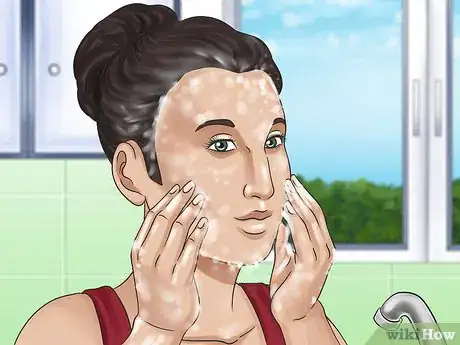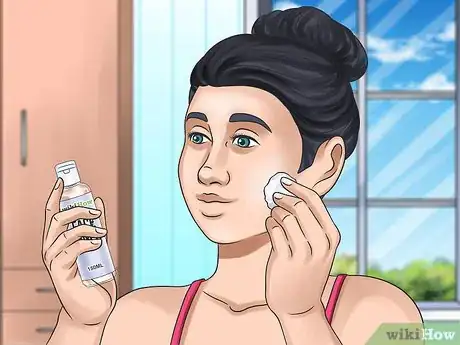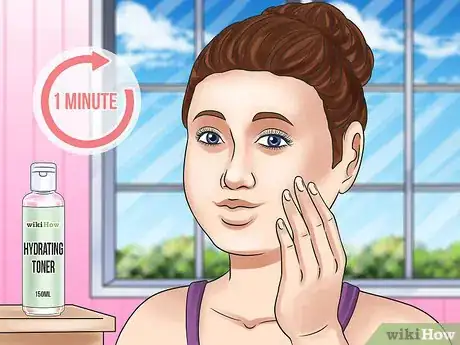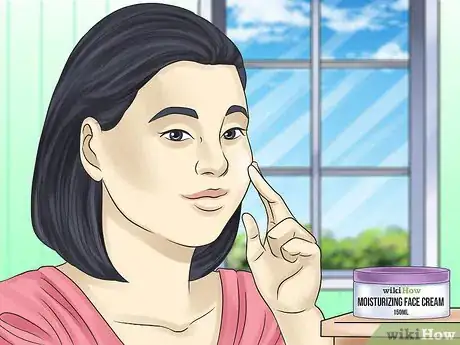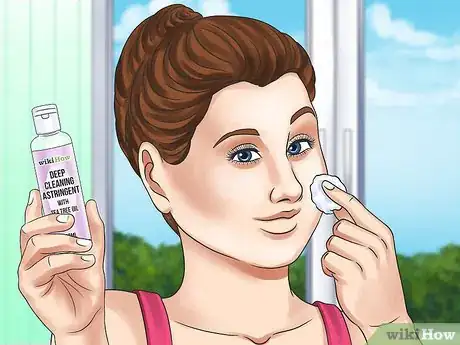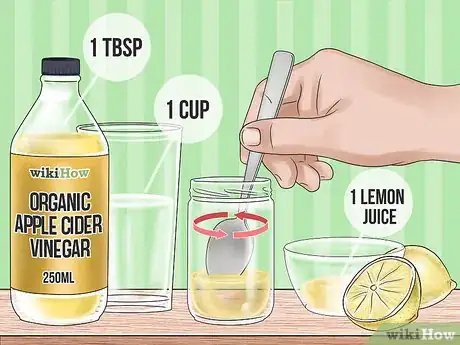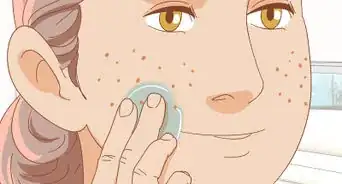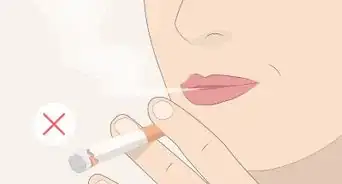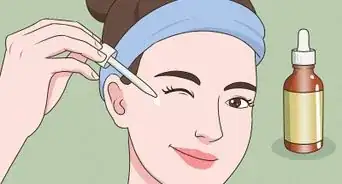This article was co-authored by Yuka Arora. Yuka Arora is a self-taught makeup artist who specializes in abstract eye art. She has been experimenting with makeup art for over 5 years, and has amassed over 5.6K Instagram followers in just 5 months. Her colorful and abstract looks have been noticed by Jeffree Star Cosmetics, Kat Von D Beauty, Sephora Collection, among others.
There are 10 references cited in this article, which can be found at the bottom of the page.
wikiHow marks an article as reader-approved once it receives enough positive feedback. In this case, 100% of readers who voted found the article helpful, earning it our reader-approved status.
This article has been viewed 367,918 times.
Using a toner is an important step in a good skincare regimen. Toner simultaneously cleanses, moisturizes, shrinks pores, balances your skin’s pH, and adds a layer of protection against impurities.[1] When adding toner to your daily skin care regimen, make sure to apply it between cleansing and moisturizing. Use a cotton pad to gently spread toner over your face and neck. When choosing your toner, look for gentle, natural ingredients that won’t dry your face out. You can also make your own toner at home tailored exactly to your skin’s needs.
Things You Should Know
- Get a cotton pad damp (but not totally wet) with your toner. Then, gently dab the cotton pad all over your face and neck.
- Before you apply other products, like moisturizer, wait 1 minute (60 seconds) for the toner to dry.
- Avoid alcohol-based toners that can dry out your skin. Instead, look for a product that's perfect for your skin, like an acne-fighting toner.
Steps
Applying Toner on Your Face
-
1Wash your face first. Use a cleanser with some warm water and a soft washcloth to cleanse your face. Gently massage the cleanser into your skin to remove makeup, dirt, and impurities.[2] Rinse well with warm water, then splash some cold water on your face when you finish. Then, blot your face dry with a clean towel.[3]
-
2Put toner on a cotton pad. Pour some toner on the pad until it feels damp but not overly soaked. You could also use a cotton ball for this step if it’s all you have on hand. However, cotton pads will soak up less product than cotton balls, which will help conserve your toner.Advertisement
-
3Lightly spread the toner over your face and neck. Use the cotton pad to gently wipe the product over your face, neck, and décolletage.[4] Avoid the eye area and be careful not to get product on your lips. Pay particular attention to crevasses and difficult-to-reach areas including the brows, sides of the nose, near the ears, and hairline. The toner will help remove the impurities that the cleanser couldn’t reach, as well as any cleanser residue or salt, chlorine, or chemicals found in tap water.[5]
-
4Mist or spritz a second toner product for extra moisture. Because a spray application can only dilute impurities, not remove them, you should always use a wiping toner first.[6] However, if you like the refreshing feeling of a misted toner, you can make it an additional toning step after using a wipe toner.[7]
-
5Wait a minute for the toner to dry. Since most toners are water-based, they absorb into the skin fairly quickly. Make sure to let the toner sink in completely before applying other products--this will help your skin retain moisture and protect against impurities.
-
6Finish by applying any treatment products and moisturizer. If you use any acne treatments, such as benzoyl peroxide, or additional moisturizers, make sure to apply those to your face after toning. Using the toner beforehand will cleanse the skin fully and allow the acne and moisturizer products to sink more deeply into the skin.
-
7Use toner twice daily. Generally, you should apply toner once in the morning and once at night. In the morning, the toner will help remove any sebum produced during the night and balance your skin’s pH. At night, the toner will help complete your cleansing routine by removing any dust, makeup, or impurities that the cleanser missed, as well as any oily residue left over from your cleanser.[8]
- If your skin is especially dry, you may want to start by using toner only once a day at night. Excessive use of toner may dry your skin out more. If you find your skin getting particularly dry, consider investing in a formula for dry skin to minimize dehydration.[9]
Purchasing a Toner
-
1Use a toner with rose water for extra hydration. Rose water is known for its hydrating, clarifying, and invigorating properties. It's perfect for skin that needs extra moisture as well as oil control. Look for toners that list rose water as a main ingredient.[10]
-
2Choose a chamomile-based toner to soothe your skin. If you struggle with dryness, redness, or sensitive skin, try a toner with chamomile.[11] This ingredient can calm skin irritation, fade spots, fight acne, and brighten your complexion.[12]
- A combination of chamomile and aloe vera can even help manage eczema and rosacea.[13]
-
3Avoid overly drying, alcohol-based toners. Alcohol is often used as an astringent in harsher toners. Many people try to use alcohol-based toners to combat acne, but this ingredient can easily irritate and dry out your skin if used too often. Opt for a gentler, alcohol-free formula instead.[14]
-
4Look for natural acne-fighting ingredients if you have oily skin. You can control your acne and still keep your skin hydrated by choosing a toner with gentler astringents. Look for ingredients such as tea tree oil, citrus juice, orange essential oil, and witch hazel.[15]
- When using an astringent, it’s best to use once daily instead of twice. Once your skin acclimates, try increasing your usage to twice daily.
Making Your Own Toner
-
1Make a green tea toner that works for all skin types. Simply mix together 1 cup (8.0 fl oz) of green tea and 1/2 a teaspoon of honey. Once the mixture has cooled, stir in 3 drops of jasmine essential oil. Keep your toner in an airtight bottle and store in a cool place.[16]
- Green tea is thought to boost skin cell rejuvenation.
- Boil the water for the tea for at least 1 minute to kill bacteria.
-
2Use an apple cider vinegar mixture for oily skin types. Make an oil-controlling toner by mixing the juice of one lemon with a tablespoon of apple cider vinegar. Stir in 200 millilitres (6.8 fl oz) of mineral water. Pour the mixture into an airtight container and store it in cool place.[17]
-
3Make your own rose water toner for sensitive skin. In a pot or dish, pour boiling filtered water over 1⁄2 cup (4.0 fl oz) a cup of dried rosebuds and let it sit for 1-2 hours. Use a strainer to separate the rosebuds out, then pour the water in an airtight container and keep it in the fridge.[20]
- Homemade rosewater needs to be used within a week, so only make as much as you’ll use in a week—1 cup (8.0 fl oz) should be sufficient.
- For extra hydration, add a few drops of geranium oil to your rose water.[21]
- You can purchase dried rosebuds online or dry them yourself.
-
4Store your toner properly. You can store homemade toners for up to 3 months after you make them. Be sure to use a clean container. If you are reusing a container, clean it out completely and boil it for at least 1 minute in fresh water prior to storing your toner.
Expert Q&A
Did you know you can get expert answers for this article?
Unlock expert answers by supporting wikiHow
-
QuestionIs toner used alongside makeup?
 Yuka AroraYuka Arora is a self-taught makeup artist who specializes in abstract eye art. She has been experimenting with makeup art for over 5 years, and has amassed over 5.6K Instagram followers in just 5 months. Her colorful and abstract looks have been noticed by Jeffree Star Cosmetics, Kat Von D Beauty, Sephora Collection, among others.
Yuka AroraYuka Arora is a self-taught makeup artist who specializes in abstract eye art. She has been experimenting with makeup art for over 5 years, and has amassed over 5.6K Instagram followers in just 5 months. Her colorful and abstract looks have been noticed by Jeffree Star Cosmetics, Kat Von D Beauty, Sephora Collection, among others.
Makeup Artist
-
QuestionWhat's the point of using cleansers and toner? Why can't I just wash my face with water?
 Yuka AroraYuka Arora is a self-taught makeup artist who specializes in abstract eye art. She has been experimenting with makeup art for over 5 years, and has amassed over 5.6K Instagram followers in just 5 months. Her colorful and abstract looks have been noticed by Jeffree Star Cosmetics, Kat Von D Beauty, Sephora Collection, among others.
Yuka AroraYuka Arora is a self-taught makeup artist who specializes in abstract eye art. She has been experimenting with makeup art for over 5 years, and has amassed over 5.6K Instagram followers in just 5 months. Her colorful and abstract looks have been noticed by Jeffree Star Cosmetics, Kat Von D Beauty, Sephora Collection, among others.
Makeup Artist All around our body, there’s good bacteria and there’s bad bacteria. Your face is no different. The cleansers help strip the bad stuff, the makeup, and the junk, and then the toner helps your skin rebalance itself. You can just use water if you want, but you're not being as thorough as you could be!
All around our body, there’s good bacteria and there’s bad bacteria. Your face is no different. The cleansers help strip the bad stuff, the makeup, and the junk, and then the toner helps your skin rebalance itself. You can just use water if you want, but you're not being as thorough as you could be! -
QuestionDo you use moisturizer or toner first?
 Laura MartinLaura Martin is a Licensed Cosmetologist in Georgia. She has been a hair stylist since 2007 and a cosmetology teacher since 2013.
Laura MartinLaura Martin is a Licensed Cosmetologist in Georgia. She has been a hair stylist since 2007 and a cosmetology teacher since 2013.
Licensed Cosmetologist
References
- ↑ https://www.today.com/series/one-small-thing/6-reasons-why-you-should-use-facial-toner-t73941
- ↑ http://www.refinery29.com/applying-skin-care-products#slide-1
- ↑ Yuka Arora. Makeup Artist. Expert Interview. 30 August 2018.
- ↑ https://intothegloss.com/2014/01/what-is-toner/
- ↑ http://www.refinery29.com/applying-skin-care-products#slide-4
- ↑ http://www.refinery29.com/applying-skin-care-products#slide-4
- ↑ http://www.refinery29.com/applying-skin-care-products#slide-4
- ↑ https://intothegloss.com/2014/01/what-is-toner/
- ↑ https://www.adorebeauty.com.au/beautyiq/how-often-should-i-use-toner/
- ↑ https://intothegloss.com/2014/01/what-is-toner/
- ↑ https://intothegloss.com/2014/01/what-is-toner/
- ↑ http://food.ndtv.com/food-drinks/13-incredible-chamomile-tea-benefits-drink-up-1629069
- ↑ https://www.womenshealthmag.com/beauty/how-to-use-facial-toner
- ↑ https://intothegloss.com/2014/01/what-is-toner/
- ↑ https://www.mostinside.com/natural-astringents/
- ↑ https://intothegloss.com/2014/01/what-is-toner/
- ↑ https://intothegloss.com/2014/01/what-is-toner/
- ↑ https://intothegloss.com/2014/01/what-is-toner/
- ↑ http://helloglow.co/2-ingredient-diy-toner-recipes-for-every-skin-type/
- ↑ http://helloglow.co/2-ingredient-diy-toner-recipes-for-every-skin-type/
- ↑ http://helloglow.co/2-ingredient-diy-toner-recipes-for-every-skin-type/
About This Article
Before you apply toner, wash your face with a cleanser and warm water, then blot your face dry with a clean towel. Once your face is dry, put enough toner on a cotton pad that the pad feels damp, but not soaked. Then, use the cotton pad to spread the toner over your face and neck, but do not spread it over your lips. Wait 1 minute for the toner to dry before applying any acne products or moisturizer. Repeat that process twice a day. For advice from our Cosmetologist reviewer on choosing or making a toner, keep reading!
